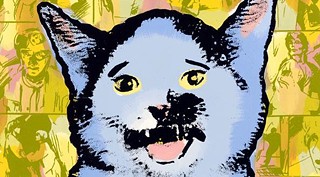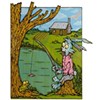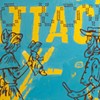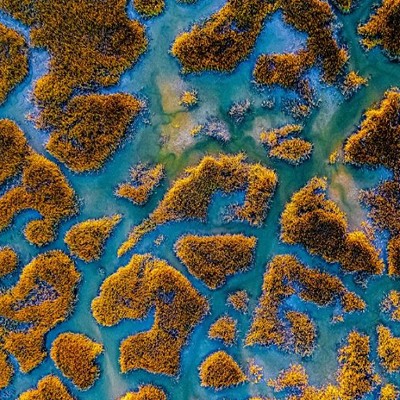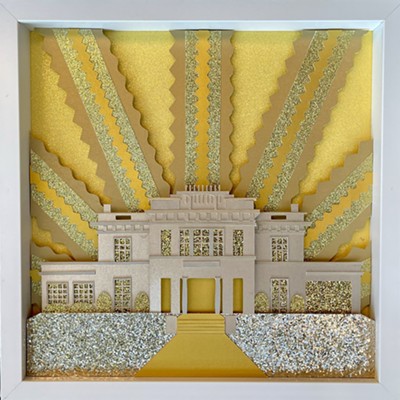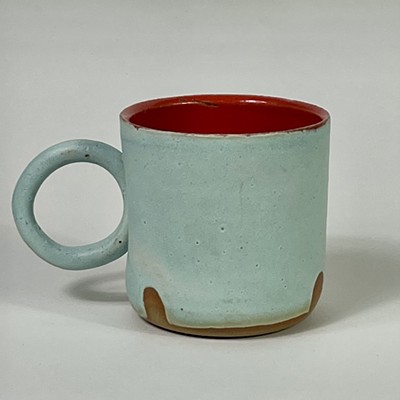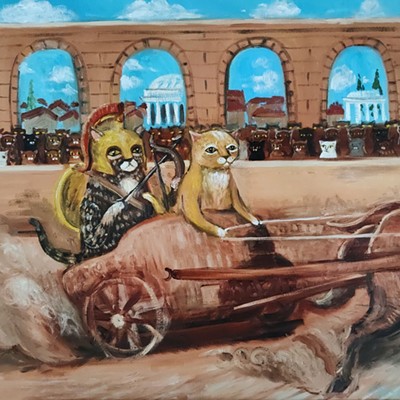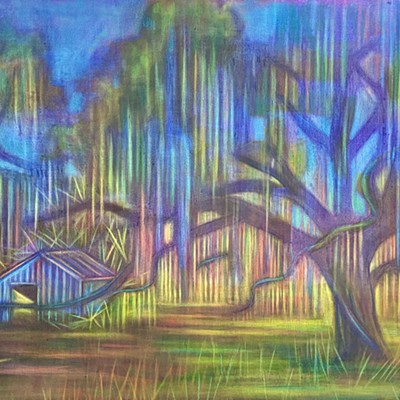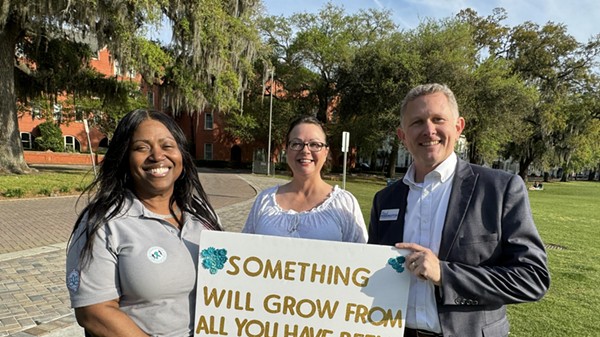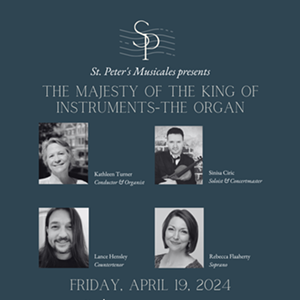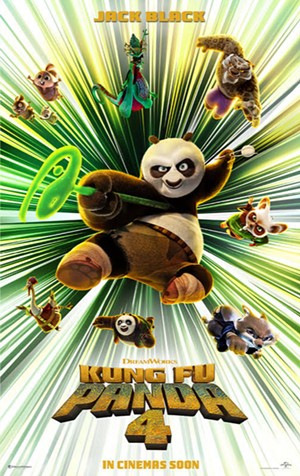R.Land may not be a household name, but for more than two decades, his work has blurred the lines between cartoons and fine art, and hidden serious messages behind hilarious street art campaigns.
Recently, Land and his twisted characters have found a natural ally with Williams Street, the Atlanta-based masterminds of popular Adult Swim shows like Aqua Teen Hunger Force, and Land is developing a show of his own for the late night Cartoon Network programming. This month a show featuring selected works from R.Land is hanging in Gallery Espresso, so we caught up with him to talk about his work, the state of counterculture, and the value of anonymity.
What sort of work will you be showing in Savannah?
R.Land: It's schizophrenic, but in a good way. There's a lot of the street art stuff that I've done in the past. There should be a couple of "Loss Cat" pieces. There's also the "Pray for ATL" image, a good number of prints and a couple paintings. I don't want to say it's a greatest hits, but there's at least one piece from things that have been happening for the last 10 years or so. It's kind of like a retrospective, but I wouldn't say it's a full on one.
Because you don't do much in the way of formal gallery shows, when you get a show outside Atlanta what do you look for in a space?
R.Land: In Atlanta, I think I've done one gallery show in 18 years because I like to find an alternative space and blow it out for a great big event. In other cities, I think the criterion is just to make sure it's a place with a good cross section of people. I'm not interested in the elite few that would go into a gallery setting. For Savannah, [Gallery Espresso] is a good place where everyone in town would go. It may be small, it's a coffee shop, but that's not necessarily a bad thing. I try to find places that speak to me, or places that I like. It can be a bar, a restaurant or a coffee shop or any place where people hang out.
What was your introduction to art? When did you realize it was something you were interested in, and wanted to pursue seriously?
R.Land: I've always been an artist. When I was a kid I wanted to be a cartoonist, but I didn't want to be just a cartoonist. I wanted to have business cards made, when I was 10 or 11, but I couldn't figure out what my title should be. I didn't like the way "artist" sounded or "cartoonist." I think I put "creator" on there, which I think is pretty hilarious. Over time it morphed. During the ‘80s I was going to a lot of New Wave clubs and hanging out with girls that worked in hair salons. I was doing paintings at home, just for fun - giant cartoons that were sort of painterly. I remember somebody seeing one at my house, and saying you should hang those at this new bar that's opening. It was the same as it is today. There's no middle man. It was just me taking my paintings to this bar, hanging them and selling them. It immediately confirmed that this was something I wanted to do. It showed me that my work could be on the walls and made me want to develop the fine art aspect of it. I don't know if it's truly fine art, but it brought me to the point where it's blurred the line between fine art, graphic design, folk art and whatever. I don't really consider myself any of those things, but it's a little bit of all those things.
Who influenced your style?
R.Land: When I was a young kid, I think I was impressed by obvious things like Walt Disney, and, on the more subversive side, B.Kliban. I loved a lot of those cartoonists that preceded Gary Larson, that were more psychedelic and more bizarre. They were people whose work I would see in magazines or books and think ‘that's the funniest shit I've ever seen.' I could connect with their sensibility more than I could with people that were more popular. They weren't like what you would see in the mainstream comic section of the newspaper. Their humor wasn't necessarily gag-oriented, and there was more thinking involved, which really spoke to me, even at a young age, because I knew I was freak from early on. They seemed like my people. A lot of people that weren't necessarily artists were inspiring to me too - musicians like David Bowie, what he was doing in the late 70s. It's not necessarily that I draw from people that are just visual artists.
With stuff like "Loss Cat" and the Aqua Teen Hunger Force DVD cover, you've reached a national audience, but done so with a certain amount of anonymity. Do you prefer it that way - to have the success and keep some of the anonymity - or would you like to be a household name?
R.Land: Being anonymous is great. It's fun to stand back and observe. Like when "Loss Cat" first started, it was just totally for kicks. I'd be out and I'd hear people talking about it. Nobody knew it was me. I was at brunch one time and I heard a couple that I knew talking about it, how funny it was and how sad. It's exciting to do that, to cause a stir. Then when it gets to a certain level I have to claim it. Like "Loss Cat" got to a point where it was all over the place, and then it popped up in the Found book. I had to call the guy from Found Magazine and tell him that it wasn't real. He could appreciate it, but he was bummed. I never would have thought that people would have believed it was real to begin with. Creatively, I also do these side projects because it's great to break out of this whole visual vocabulary that I've been working with for years. I've got all these things I want to say, but I don't want to say them with the same basic vocabulary or have it even be obviously from me.
As a counterculture artist, as you branch out into these bigger projects full of licensing rights and contracts - does it seem like the counterculture has changed? Has it been infiltrated by big business?
R.Land: It's drastically changed. I don't know how well something like "Loss Cat" would have done 20 or 30 years ago. I think a lot about what kinds of music would work in the mainstream. I'm always disappointed when some song that I really love shows up in a commercial, like David Bowie's "Heroes." It's a great song that really pushed the envelope of what was acceptable as pop music in its day. I know he's a famous artist, but I thought that song was fairly inaccessible for a commercial, for selling something, but we got to that point. I think Sonic Youth can sell a product now. What wouldn't be acceptable in a commercial, and is that the way you measure whether something is still counterculture? I'm getting off on a tangent, but I think we've gotten to a point where almost anything goes. I think I know what mainstream is, but then you see things in mainstream culture that seem like they should be more underground. It's not that I'm opposed to it. I just think that a lot of the mass culture stuff is very disappointing, and that we could do way better.
R.Land's show at Gallery Espresso (234 Bull St.) will be up through the end of the month. To check out more of his art, visit www.rlandart.com.

